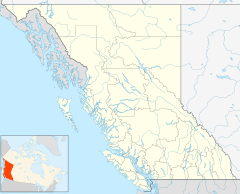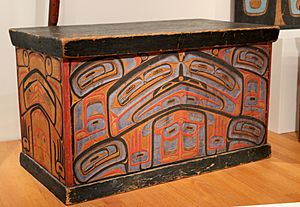Heiltsuk Nation facts for kids
Quick facts for kids
Heiltsuk Nation
|
|
|---|---|
| Country | |
| Government | |
| • Type | First Nations Council |
| Population | |
| • Total | c. 1,600 |
| Time zone | [[UTC-7 UTC−7]] (Pacific Time Zone (PTZ)) |
| • Summer (DST) | DST |
| Postal code span |
V0T 1Z0
|
| Area code(s) | 250 |
| Website | Official Website: http://www.heiltsuknation.ca |
| PO Box 880, Bella Bella, BC, Canada | |
The Heiltsuk Nation is a First Nations government located on the Central Coast of British Columbia, Canada. Their main community is Bella Bella, British Columbia, found on Campbell Island. The Heiltsuk people speak the Heiltsuk language. In the past, they were sometimes called the "Bella Bella" after their main village.
Today's Heiltsuk First Nation is made up of five tribal groups. These groups lived in an area of about 6,000 square miles along the Central Coast of British Columbia. The Heiltsuk people traditionally used both the land and the sea for their survival. Their territory stretches between Milbanke Sound and Fisher Channel. This area includes many inlets, islands, peninsulas, mountains, and valleys. Rivers and streams flow into the sea through thick forests.
Heiltsuk oral traditions say that their first ancestors were placed in different spots within their territory by the Maker. They were living there even before a Great Flood. Scientists have found proof that people have lived in this area for at least 14,000 years. About 1,400 of the 2,200 Heiltsuk members live on Campbell Island. This island is about 78 nautical miles from the British Columbia mainland. It is also 98 nautical miles from Vancouver Island.
In 1997, a big court case called R. v. Gladstone decided that the Heiltsuk have an Aboriginal right to trade in herring. This was the first time a court in Canada recognized a commercial Aboriginal right. Even after winning this case, disagreements continued about how the Heiltsuk could access herring and how the fish stocks were managed. In 2015, a serious situation happened during the herring fishing season. It involved the Heiltsuk and the Canadian government's Department of Fisheries and Oceans (DFO). The conflict ended when the commercial fishing boats left without fishing.
Recently, a fire destroyed the only food store in the village. The United Church quickly stepped in to become the "United Store" while a new building was constructed. This quick action helped the community during a tough time.
The Heiltsuk have also strongly opposed the Enbridge Northern Gateway Pipelines project. They held well-known public meetings in Bella Bella to share their concerns.
In the 1990s, the Heiltsuk were involved in early efforts to protect the Great Bear Rainforest. On January 29, 2016, they celebrated a final agreement to protect this huge coastal temperate rainforest. This celebration took place in Bella Bella with other First Nations, businesses, government, and environmental groups.
An archaeologist named Alisha Gauvreau found an ancient site on Triquet Island. This discovery seems to support the Heiltsuk oral traditions. Her team excavated a settlement in the Heiltsuk Nation's traditional territory. They found that it was settled 14,000 years ago, during the last ice age. At that time, glaciers covered much of North America.
Contents
Heiltsuk Leadership and Governance
The Heiltsuk Nation chooses a chief and 11 councillors. These leaders serve for a term of two to four years. Elections follow a special code based on the Indian Act. The most recent election was held in 2018.
The current Chief Councillor is Marilyn Slett. She works with the other councillors to lead the Heiltsuk Nation.
Heiltsuk Language and Communication
The Heiltsuk people speak Hailhzaqvla, which means "the Heiltsuk language." This language is part of the Heiltsuk-Oowekyala language family. It is a central part of the northern branch of the Wakashan language family.
The Heiltsuk also knew and used the Chinook jargon. This was a special trade language used to communicate between different language groups.
Economic Development for the Heiltsuk Nation
The Heiltsuk Economic Development Corporation (HEDC) was created in 2006. It was set up by the Heiltsuk Tribal Council. The HEDC manages the business activities of the Heiltsuk people. This helps to keep business and politics separate. It also supports the community's goals for economic growth.
Education and Cultural Preservation
The Heiltsuk Cultural Education Centre is located inside the Bella Bella Community School. It was started in 1975. This center shows the Heiltsuk people's strong commitment to keeping their culture alive.
The Heiltsuk Cultural Education Centre works to research, preserve, and bring back the history, language, and traditions of the Heiltsuk Nation. They have been doing this for over twenty years.
The Heiltsuk people have also brought back the tradition of ocean-going canoes. In July 2014, Bella Bella hosted a large canoe festival called Qatuwas. About 60 canoes traveled to the festival. They came from as far away as Washington State and from other First Nations along the coast.
The Heiltsuk people worked hard to have their own schools. The Bella Bella Community School is now run by the Heiltsuk Nation. It offers schooling from kindergarten through grade 12.
Protecting the Great Bear Rainforest
The Heiltsuk territory is in the middle of the Great Bear Rainforest. This is the largest untouched old-growth forest in the world. The Government of British Columbia officially recognized the Great Bear Rainforest in February 2016. It is Canada's part of the Queen's Commonwealth Canopy (QCC). This is a special forest conservation effort started in 2015. It now includes 16 of the 52 Commonwealth nations. Industrial logging in the Great Bear Rainforest will be reduced. This will help to permanently protect 85% of the forest.
On October 13, 2016, an American tugboat called the Nathan E Stewart ran aground. It was carrying about 200,000 liters of industrial oils, including diesel. The tugboat was pulling an empty oil barge. It hit a reef near Athlone Island close to Bella Bella. This happened when the tugboat missed its turn into Seaforth Channel while traveling in Canadian waters.
Heiltsuk Fishing Rights and Disputes
The Heiltsuk people have a long and important history with herring fishing. The 1997 Supreme Court of Canada decision in R. v. Gladstone was a very important legal win for the Heiltsuk. The court decided that the Heiltsuk have an existing Aboriginal right to herring, which includes the right to trade them.
Since the Gladstone decision, the Heiltsuk have had disagreements with Canada. These disputes are about how the ruling is put into practice and about the scientific information used by the DFO. The disagreements became very serious in 2015. At that time, Heiltsuk people protested by occupying the local DFO office.
See also





